-
Posts
14,343 -
Joined
-
Last visited
-
Days Won
25
Content Type
Profiles
Forums
Blogs
Gallery
Events
Store
Posts posted by Ed_Haynes
-
-
Second spread.
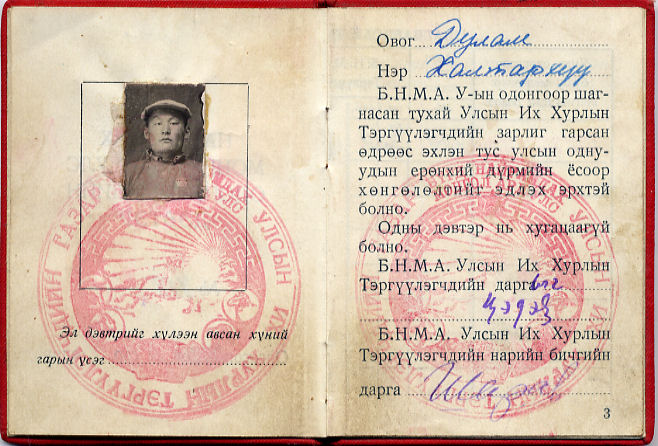
 0
0 -
First page.
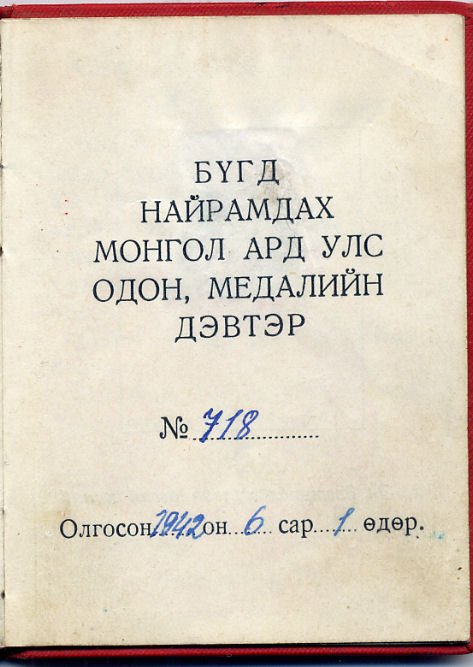
 0
0 -
Some of the high-points of some recent documents follow.
1
Cover
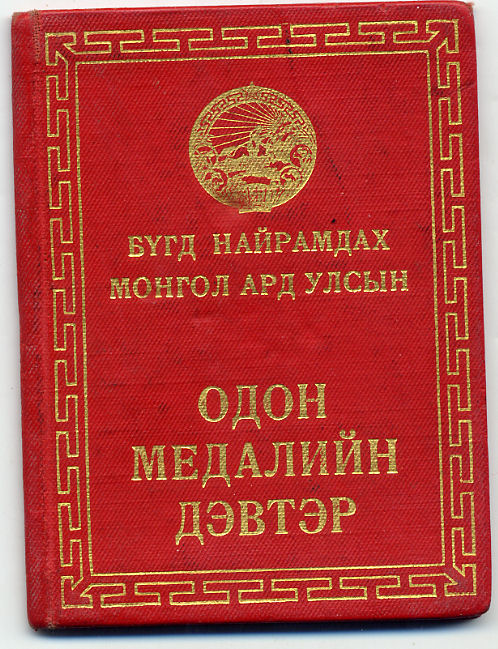
 0
0 -
OK, I'll admit to being QUITE confused by some of these data points (all are document-based), let me throw these out for consideration. I'll be posting some of the more interesting documents over time.
Sukhbaatar
186 -- 6-7-1960
Red Banner of Military Valor (A22.1)
859 -- 8-9-1939
4125 -- 30 June 1986
Order of Combat Valor
14 -- 6-7-1946
391 -- 11-9-1953
603 -- 27-11-1958
Polar Star
270 -- 6-7-1946
1029 -- 26-9-1945
2313 -- 26-9-1945
2824 -- 5-2-1949
5556 -- 17-9-1953
5941 -- 24-7-1948
8712 -- 22-10-1959
13809 -- 3-6-1971
17522 -- 10-6-1976
(My brain hurts!)
Honorary Medal of Combat
902 -- 10-7-1941
2974 -- 9-11-1948
3159 -- 20-8-1951
3191 -- 20-8-1957
3561 -- 5-7-1956
4125 -- 30-6-1986
4144 -- 23-9-1948
4794 -- 9-7-1982
6094 -- 22-7-1946
7622 -- 8-7-1947
(I am very confused now.)
Honorary Medal of Labor
7982 -- 11-3-1959
16335 -- 11-11-1960
16634 -- 23-7-1965
Motherhood 2nd class
145926 -- 4-3-1985
158495 -- 24-5-1988
196039 -- 10-5-2000
25 Years MPR
00033 -- 12 May 1947 (And how I wish I had the matching medal!)
40 Years MPR (A43)
119 -- 7-7-1961
1974 -- 7-7-1961
29673 -- 28 September 1961
(Some corrections, thanks Rick and Jan. Otherwise being updated on a rolling basis as new things surface, until Bob updates the master list.)
0 -
Handsome medal Ed! I like the reverse particularly...much more decorative than so many medals these days. reminds me of the British medals of the late 1800s to some extent.
Absolutely, fine detail work and much superior to the rubbish being issued by most countries today (India included).
0 -
OK, I don't claim to know much about the PLM, but . . .
 0
0 -
Along with Canada, India was heavily committed to peacekeeping operations. UNEF and the Congo come to mind. The Indians suffered casualties in both - the former when caught by the start of the Six Day War in 1967, and of course they were heavily engaged in combat in the Congo.
I have two of these medals in my collection: a sepoy in the 9th Dogra for UNEF, and a Gorkha in 3/1st Gorkha Rifles for Congo (where Capt. G.S. Salaria won a posthumous Param Vir Chakra).
A good summary and roll of honour is here: http://indianarmy.nic.in/arunpk1.htm
Yes, If you glance over at
http://gmic.co.uk/index.php?showtopic=2450&st=1
you'll see the Sena Medal group to the havildar who got Salaria's men out of the mess he'd walked them into (after he was killed and thereby won his PVC).
0 -
Lukasz,
This came straight from Prof. Wesoloski and the text and description straight from his book. This is a Type I. Type II has no enamel. I've been mentored by Doc Wes for some time now. If he says it's a Type I then it is a Type I.
 Doc
DocAnd he can't be wrong? Just like Paul & Paul couldn't be wrong on Soviet motherhood medals? Oops.
0 -
Interesting idea. I doubt whether the Shah-Pretender knows much personally, but he may have people who do.
0 -
Christopher Buyers' site has some information, but not much, no where near enough!
http://www.4dw.net/royalark/Persia/Orders/persia-orders.htm
Also Yuri's site
http://www.netdialogue.com/yy/Asia/Iran/KIran/Iran.htm
but, as with so much, not much except on the orders.
Can we do better here? Please??
0 -
One of my favourites.
Created by Presidential Notification No.15-Pres./60 of 26 January 1960 and Not. No. 32-Pres./60 of 2 June 1960, with effect from 15 August 1947. The first clasps as well as eligible categories of personnel were notified in MoD Notification No 1399, dated 22 July 1960. Ministry of Defence notifications in the Gazette of India Part 1, Section 3, at varying times commencing from Notification No. 1399 of 22 July 1960 have authorized additional clasps. The design of the medal itself was modified by No.52-Pres./68 of 22 July 1968.
Awarded to military personnel for services outside of India. Personnel assigned on the regular staff of diplomatic missions in the countries where clasps have been authorized are excluded from awards. In many cases, the clasps are awarded either for service with the United Nations or other multi-national missions or for detached service on loan to foreign governments. In May 1970 it was decided that the following categories of service were in future recognized for institution of a clasp to the medal irrespective of the number of personnel involved:
- (a) campaign service or service in peace-keeping roles with the UN; and
- (b) deputation with other countries in various capacities as Trainers, Advisors and to fill up specific posts for temporary periods, etc.
This has resulted in some extremely small numbers of qualifying personnel. In general, the qualifying period is graduated according to the length of the specific service: for assignments over a year, the qualifying period is six months; for assignments less than a year, the qualifying period is three months. Exceptions are made for special cases. The medal may be awarded posthumously. Moreover, a person who died or was evacuated due to wounds or other disabilities attributable to service in the countries and during the service specified or who was awarded a gallantry award in the course of such service would qualify automatically for the award of a clasp even if he did not meet the minimum stipulated qualifying service period.
Although the instituting notification stipulated that the medal was to be awarded for "for such service abroad . . . which has not been considered for any other Indian medal" on at least one occasion, the Videsh Seva medal (with clasp Sri Lanka) has been awarded in conjunction with another medal, the Special Service Medal with clasp "Sri Lanka", awarded for service with the Indian Peace Keeping Force. As the notification implies, non-India medals are frequently bestowed for the same service as the Videsh Seva Medal, most commonly for United Nations or other multinational peacekeeping operations.
The various clasps (all clasps in Hindi only) thusfar identified (listed by the soon-to-be-standard Haynes-Chhina number):
1051.301 Korea (1950-54)
1051.302 Nepal (1952?)
1051.303 Indochina (1954-70)
1051.304 Indonesia (1955-??)
1051.305 United Arab Republic (1956-??)
1051.306 Ethiopia (1957?, 1961?, 1970?)
1051.307 Lebanon (1958, 1998?)
1051.308 Ghana (1959?)
1051.309 Iraq (1959?)
1051.310 Sri Lanka (1960?)
1051.311 Congo (1960-64, 1999?)
1051.312 Bhutan (1961?)
1051.313 New Guinea (1962-63)
1051.314 Yemen (1963-64)
1051.315 Nigeria (1963?)
1051.316 Algeria (1963?)
1051.317 Cyprus (1964?)
1051.318 Malaysia (1966?)
1051.319 Afghanistan (1970?)
1051.320 Bangladesh (1972)
1051.321 Mauritius (1973?)
1051.322 Botswana (1973?)
1051.323 Zambia (1973?, 1994?)
1051.324 Sudan (1976?)
1051.325 Oman (1976?)
1051.326 Qatar (1988?)
1051.327 Tanzania (1988?)
1051.328 Iran-Iraq (1988-91)
1051.329 Maldives (1988)
1051.330 Seychelles (1989?)
1051.331 Angola (1989?)
1051.332 Namibia (1989-90)
1051.333 Nicaragua (1990-92)
1051.334 Honduras (1990-92)
1051.335 Guatemala (1990-92)
1051.336 Costa Rica (1990-92)
1051.337 El Salvador (1990-95)
1051.338 Iraq-Kuwait (1991?)
1051.339 Western Sahara (1991?)
1051.340 Cambodia (1991-93)
1051.341 Yugoslavia (1992-95)
1051.342 New York (1993?)
1051.343 Somalia (1993-95)
1051.344 Mozambique (1993-94)
1051.345 Haiti (1993-96)
1051.346 Liberia (1994?)
1051.347 Rwanda (1994-96)
1051.348 Laos (1995?)
1051.349 Bosnia and Herzegovina (1995?, 1998?)
1051.350 Sierra Leone (1998?)
1051.351 Kosovo (1999?)
1051.352 Northern Iraq (2000?)
1051.353 Lesotho (2000?)
1051.354 Ethiopia and Eritrea (2000?)
The medal shown is for Korea, named to "3930754 HAV. RAMDASS, A.E.C." - what was the Army Educational Corps doing with the NNRC?
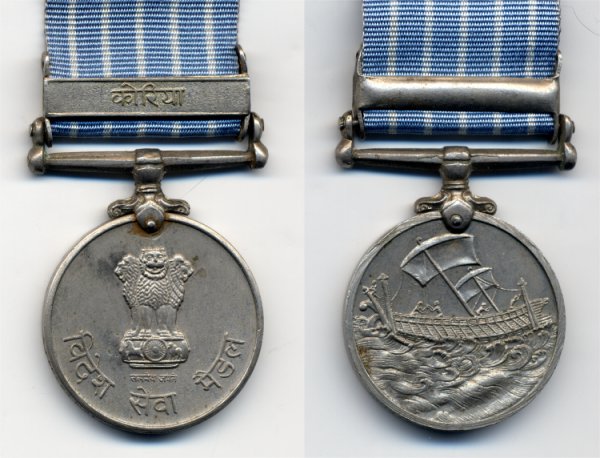

 1
1 -
The clasps.
Jammu-Kashmir / NEFA
Himalaya / Bengal-Assam
Andaman and Nicobar / Marusthal


 0
0 -
One of the most common post-1947 medals, virtually impossible to avoid.
Sainya Seva Medal / Service Medal
Awarded in recognition of non-operational services under conditions of special hardship and severe climate.
Established: By No.14-Pres./60 of 26 January 1960, by the President of India (with effect from 15 August 1947). Expanded in No.32-Pres./60 of 2 June 1960 and revised by No.56/Pres./68 of 3 August 1968.
General Appearance: Circular 36-mm copper-nickel medal.
Obverse: An image of the Nanda Devi mountain peak with a bamboo stand in the foreground.
Reverse: The gate to a medieval fort (actually the Delhi Gate at Purana Qila in New Delhi). Above, there is the Hindi legend ?Sainya Seva Medal?.
Ribbon: 32 mm, orange-saffron, with two 1-mm stripes, white and green. As it has been so common and so widely produced, there is some considerable variability of the precise shades of the colors in this ribbon. These color variations have no significance (as some have stated).
Suspension: Suspended by a straight-bar suspender to which the clasps are attached.
Naming: The medal is normally named on the edge.
Miniature: Miniatures have been issued. Clasps are also seen in a wide range of official and unofficial styles.
Background: Awarded in recognition of non-operational services under conditions of special hardship and severe climate. The medal has been very commonly awarded and may well be said to be the most common award in the Indian military.
Clasps: The medal was not awarded without a clasp. While all clasps observed have been produced in Hindi rather than English, they will frequently be referred to by their English names.
Outline:
Jammu and Kashmir ? Instituted by Not. No.32-Pres./60 A.I. 298/60 of 2 June 1960; amended by A.I. 84/67 and A.I. 51/73. Awarded: (a) for an aggregate of one year of service in Jammu and Kashmir after 27 October 1947, service which qualified for the appropriate bar to the 1947 General Service Medal or for the ?Himalaya? bar to the Sainya Seva Medal will not be counted; (B) air force personnel who have carried out a minimum of ten sorties or forty hours of flying after 27 October 1947, with the same limits to overlapping service applying here as well. Between the two words on the clasp is a depiction of a chinar leaf.
NEFA ? Instituted by Not. No.32-Pres./60 of 2 June 1960 and A.I. 298; amended by A.I. 157/66 and A.I. 51/73. Awarded: (a) for an aggregate of one year of service in the North-East Frontier Agency (NEFA) employed in the construction of roads and airfields between 7 October 1952 and 15 November 1958; (B) personnel seconded to the Assam Rifles who have completed an aggregate of one year of service in NEFA (excluding those areas for which the ?Himalaya? clasp was awarded) after 15 August 1947; ? air force personnel who carried out a minimum of ten sorties or forty hours of flying after 7 October 1952. The clasp is designed to look like a horizontal stalk of bamboo. While going through the proposal of the Chiefs of Staff Committee for the institution of the High Altitude Nedal, to be awarded in lieu of the clasp ?Himalaya?, the Defence Minister suggested that the clasp ?NEFA? should be renamed as ?Arunachal?, since the erstwhile Agency had been incorporated into the Indian Union.
Himalaya ? Instituted by Not. No.32-Pres./60 of 2 June 1960 and A.I. 298/60; amended by A.I. 45/64 and A.I. 156/66. Awarded: (a) for an aggregate of one year of service in the defence of the northern in areas (roughly: portions of NEFA, the Tibet borders in Uttar Pradesh and Jammu and Kashmir, and Sikkim) and time periods specified by the government; (B) air force personnel who carried out a minimum of ten sorties or forty hours of flying in areas and time periods specified by the government. Between the two partial words on the clasp (indicated above by the space in the Hindi) is a depiction of a pine (cedar?) tree. Award of this clasp was terminated with the creation of the High Altitude Service Medal in 1986. A total of 2,27,000 clasps had been issued till September 1988.
Bengal-Assam ? Instituted by A.I. 298/60; amended by A.I. 34/67. Awarded: (a) for an aggregate of one year of service in specified areas on West Bengal and Assam after 26 October 1962; (B) for 10 sorties or 40 hours of flying over specified areas on West Bengal and Assam after 26 October 1962. The clasp is plain.
Andaman and Nicobar ? Instituted by A.I. 298/60; amended by A.I. 34/67. Awarded: (a) for one year of aggregate service in the Andaman and Nicobar Islands after 20 May 1966; (B) for 50 hours of flying in the Andaman and Nicobar Islands after 20 May 1966. At either end of the unusually ornate clasp, there is a lotus flower.
Marusthal ? Instituted by MoD Notfn. No. 12 dated 20 July 1984. Awarded: (a) for one year of aggregate service in the qualifying desert areas; (b) to aircrew for 10 sorties or 40 hours of flying over specified areasThe clasp is plain.
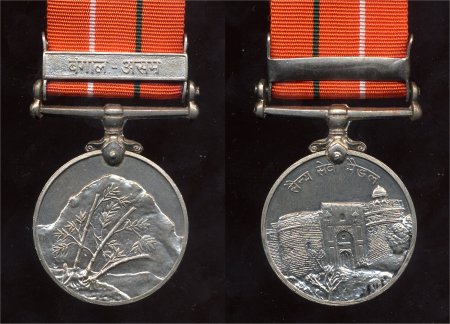

 0
0 -
Dear Christian:
Like I said in the post, Igor has the customer base to do that - he has people who have the money in St Petersburg and Moscow and Kiev who are willing to pay. These contacts I don't have, unfortunately. C'est la vie!
Dave
Not "unfortunate" for us, Dave.
 0
0 -
Nice one Ed.
 Looks like he is only missing one clasp to the Sainya Seva also, which one is missing?
Looks like he is only missing one clasp to the Sainya Seva also, which one is missing?The Andaman and Nicobar clasp. He was in the Air Force. It is an almost exclusively naval clasp (and was instituted late -- rather like the British Atlantic Star -- to answer demands that there was nothing for them to earn).
Have added coverage of the Sainya Seva Medal: http://gmic.co.uk/index.php?showtopic=14654.
0 -
A nice multi-clasp Samanya Seva (well, multi-clasp almost everything!). Perhaps one of the few these days to care enough to improvise attachments for the clasps.
One clasp missing. Qualified also for "Suraksha" on the Vishesh Seva.
One other medal not shown here.
Anonymity preferred by the recipient.


 0
0 -
The only Nathula-Chola I have (or have ever seen) is part of an eccentically mounted group (but still nice):
1233117 Havildar (RHM?) Sohan Lal, Artillery
1- Sangram Medal - 1233117 GNR SOHAN LAL ARTY
2- Samanya Seva Medal, "Nathula-Chola 1967" - 1233117 GNR SOHAN LAL ARTY - probably THE rarest GSM clasp, more uncommon than "Overseas Korea"?
3- Long Service and Good Conduct Medal - 1233117 HAV SOHAN LAL ARTY - while mounted blissfully out of order, it actually has the right ribbon
4- Sainya Seva Medal, "Jammu-Kashmir" - 1233117 GNR SOHAN LAL ARTY
5- 25th Independence - 1233117 GNR SOHAN LAL ARTY
6- 20 Year - 1233117 RHR [?] SOHAN LAL ARTY
7- 9 Year - 1233117 GNR SOHAN LAL ARTY

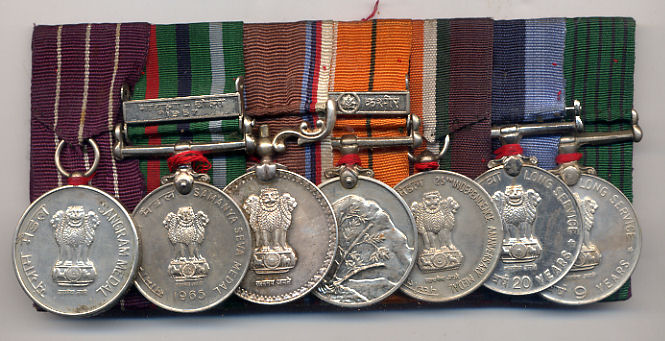

 0
0 -
2- Nathula Chola - see below
3- Nagaland - SS-30153 2-LT. PETER. GARH RIF.
4- Mizoram - 14295071 SIGMN JAGDISH KUMAR, SIGS.
5- Tirap - 4457844 Si. Jit Singh, Si. La. I. (named in Hindi)
6- Manipur - 13611482 HAV. R. SINGH, PARA R. (clasp badly bashed, sorry)
Let me know if you need/want close-ups on the clasps.


 0
0 -
As a successor to the 1947 General Service Medal -- and, confusingly, overlapping that award and to a degree apparently duplicating it -- the Samanya Seva Medal [General Service Medal] 1965 was established by No.35-Pres./75 of 8 May 1975, by the President of India (with effect from 26 January 1965). The description of the ribbon was modified by No.28-Pres./78 of 13 May 1978.
It is a circular 35-mm copper-nickel medal. The obverse shows the state emblem of the Ashokan lions and, to the left "Samanya Seva Medal" in Hindi and to the right ?SAMANYA SEVA MEDAL? in English. At the bottom, the date ?1965?. The medal is suspended by a straight-bar non-swiveling suspender to which the clasps are attached. The naming is usually impressed on the edge. Hindi naming is also encountered.
The reverse is simple, showing the Indian elephant badge, drawn from the design of the flag of the Indian president.
The ribbon is 32 mm, dark green with three, equally spaced, 3-mm stripes of red, dark blue, and light blue. As it has been so common and so widely produced, there is some variability of the precise shades of the colors in this ribbon. These color variations have no significance (as some have stated). Early awards were originally ordered to be worn on the IGS 1947 ribbon, but this silly order later got changed.
Clasps - almost all clasps have been issued in Hindi only, so this may pose problems to the collector.
1- Kutch?Kargil 1965 - For actions against Pakistani troops in western and northern India from April 1965 to January 1966 in two widely diverse environments: the salt flats of Kutch (in Gujarat State) or in the Kargil sector of the high Himalayas. Kutch: one day of service in battle between 9 April 1965 and 1 May 1965 or ten days of general services in Kutch between 9 April 1965 and 1 July 1965. These were border clashes preliminary to the full-scale 1965 Indo-Pakisnai War. (This bar is illustrated above.)
2- Nathula Chola - For service along the Sino-Indian border for one day of service in the border incidents at Nathula (11-16 September 1967) or Chola (1 October 1967).
3- Nagaland - Awarded for anti-insurgent service in Nagaland in north-eastern India from 8 May 1975 to date. Earlier service was recognized by the ?Naga Hills? bar to the General Service Medal, 1947.
4- Mizoram - Awarded for service in the Mizo areas of Assam or in ?Operation Orchid?, in anti-insurgency operations, from 8 May 1975 to date. Earlier service was recognized by the ?Mizo Hills? bar to the General Service Medal, 1947.
5- Tirap - Awarded for service in counter-insurgency operations in the Tirap district of Arunachal Pradesh after 1 June 1979.
6- Manipur - Awarded for service in counter-insurgency operations in Manipur with effect from 27 September 1980. This is the only bilingual (Hindi/English) bar to the medal.
While the qualifying periods for many of these clasps are still officially "open", the medal seems to have fallen out of official favor and seems to have gone moribund.
The Kutch?Kargil 1965 medal illustrated is named to "4439136 SEP. WARYAM SINGH, S. L. I."
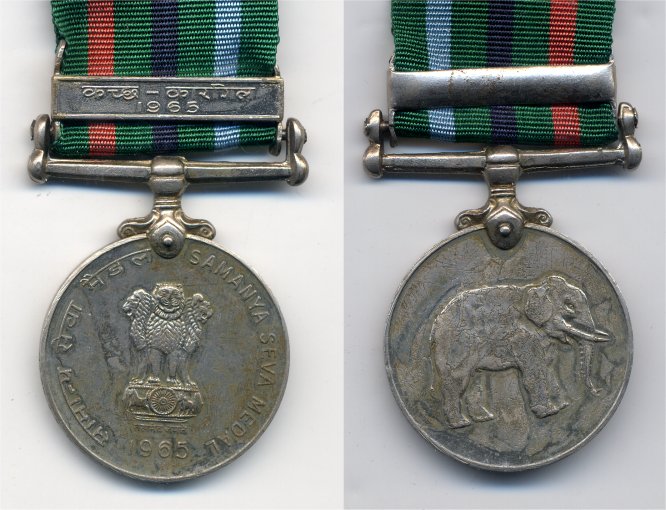

 0
0 -
One of the few multi-clasp IGS 47 groups I have seen. Not mine, of course, and image leaves some things wanting, but still nice.
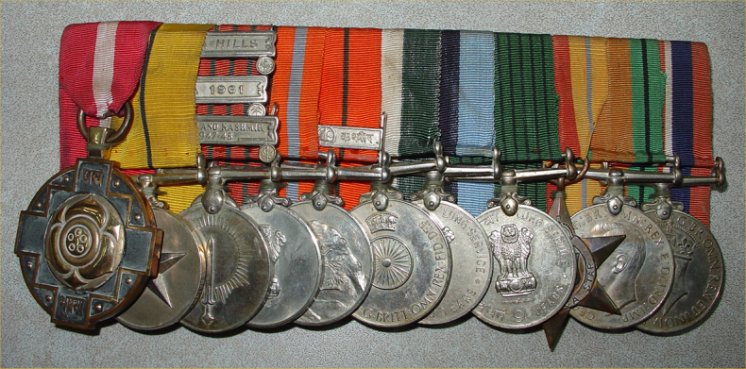

 0
0 -
5- Ladakh 1962 - JC-12615 SUB VISHWNATH SINGH, RAJPUT R.
6- NEFA 1962 - 1162613 L-NK JODHARAJ, ARTY.
7- Mizo Hills - 2862325 RFN. CLK. KANSHI RAM, RAJ RIF.


 0
0 -
2- Overseas Korea 1950-53 - 43.43-10 JEM A-ASST. MOHAN LAL, A. M. C. - 60th Para Field Ambulance - Enlisted 19 September 1940, Jemadar 10 July 1953
3- Naga Hills - 339007 SEP. JAGIR SINGH, SIKH R.
4- Goa 1961 - 1121601 HAV. DILBAG RAI, ARTY. - In 17th Artillery Brigade?, 17th Infantry Division Task Force.


 0
0 -
A draft royal warrant was prepared in January 1949 for the possible institution of this award in the name of the British sovereign as, during the dominion period, such a step would have been necessary to give the award status within the Commonwealth. On consideration, this course was abandoned and the medal was created by No.3-Pres./50 of 5 June 1950, by the President of India (with effect from 15 August 1947). The reverse designs were altered by Presidential amendments No.30-Pres./54 of 21 June 1954 and by No.49-Pres./54 of 6 December 1954.
General Appearance: A circular 35-mm copper-nickel medal. The medal is suspended by a straight-bar non-swiveling suspender to which the clasps are attached. The naming is usually impressed on the edge. The clasps are distinguished by having different motifs in the "roses" at their ends. As later bars were issued loose to the soldiers, and had to be mounted by them, multi-bar medals are uncommon.
Obverse: A representation of Bhavani, or the "divine sword of justice and true discrimination", point upward and within a halo.
Reverse: The original design of 1950, which was never issued, described the reverse: in the center, a lotus flower with buds with the legend above ?The General Service Medal? and, below, ?1947?. In June 1954, the lower reverse legends were altered to read ?1947? with ?INDIA? just above this. Finally, in December 1954, the design of the reverse as actually issued was specified as having the upper inscription read ?GENERAL SERVICE? and, below, ?INDIA?. No specimens have been seen of the first two reverses, though prototypes may exist.
Ribbon: 31 mm, red with five 1-mm dark green stripes. As it has been so common and so widely produced, there is some variability of the precise shades of the colors in this ribbon. These color variations have no significance (as some have stated). The notifying gazette unusually specified the sybolic significance of the ribbon colours; red representing valour and passion, and green, auspiciousness. There is, however, the indication that after the creation of the Samanya Seva Medal, 1965, in 1975, orders were issued that this medal should be worn from the ribbon of that later medal; this directive seems to have been widely (and appropriately) ignored.
Over the lifespan of the medal, before its replacement by the Samanya Seva Medal 1966 (which seems now to have gone moribund), seven clasps (all in English, unlike most other post-1947 Indian medals) were issued:
1- Jammu and Kashmir 1947-48 - For one day of service in specific battles within the geographical limits of Jammu and Kashmir State in the first Indo-Pakistani conflict over Kashmir, 24 October 1947 to 1 January 1949. The bar has chinar leaves at the ends.
2- Overseas Korea 1950-53 - For one day of service ashore in Korea between 22 November 1952 and 8 July 1953 on the active strength of the 60th Para Field Ambulance Unit. Probably the rarest of the medals for the Korean War. The bar has a caduceus ascending from a lotus flower at the ends.
3- Naga Hills - For 180 days (90 days for temporary inductees) of operational service in the Naga Hills or Tuensang area of northeastern India between 27 April 1955 and 1 April 1956. Awarded for the first phases of a particularly nasty anti-insurgency campaign that still simmers to this day. The bar has atalks of bamboo in the roundels at the ends.
4- Goa 1961 - For service in ?Operation Vijay?, the reunification with India of the remnant Portuguese colonies along India?s coast. This bar was awarded for two days (48 hours) of actual service within the geographical limits of Goa, Daman and Diu from 18 to 22 December 1961. The bar has a palm tree at the ends.
5- Ladakh 1962 - For services against Chinese forces in Ladakh, along India?s northern borders, 20 October 1962 to 21 November 1962. This is one of two bars for the 1962 war with China. The bar has mountains at the ends.
6- NEFA 1962 - For services against Chinese forces in the North-East Frontier Agency (NEFA), along India?s northeastern borders, 10 October 1962-21 November 1962. This is one of two bars for the 1962 war with China. The bar has a leafy tree tree at the ends.
7- Mizo Hills - Awarded for 180 days (90 days for temporary inductees) of operational service deployed and operating in the erstwhile Mizo District of Assam between 20 February 1966 and 8 May 1975. The ?Mizo Hills? bar has uniquely plain ends.
The successor medal, the Samanya Seva Medal 1965, would be awarded with six clasps, covering services from 1965 to the present. Although the medal appears today to have become moribund, as has the GSM model in the UK.
The medal illustrated, for Jammu and Kashmir 1947-48, was awarded to "5092 SEP. KARTAR SINGH, 1 PATIALA INFANTRY S. F."


 0
0 -
And a nice group.
United Arab Emirates (Dubai)
1- Dubai Defence Force Commemoration Medal
2- 1976 Armed Forces Amalgamation Medal
3- Military Unity Star, 1986
See also: http://gmic.co.uk/index.php?showtopic=2454
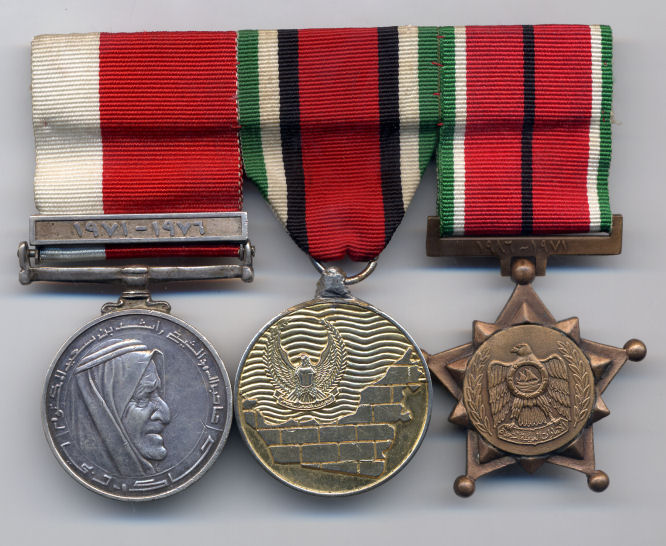

 1
1




Documents a gogo !
in People's Republic Mongolia
Posted
Closeup of him.